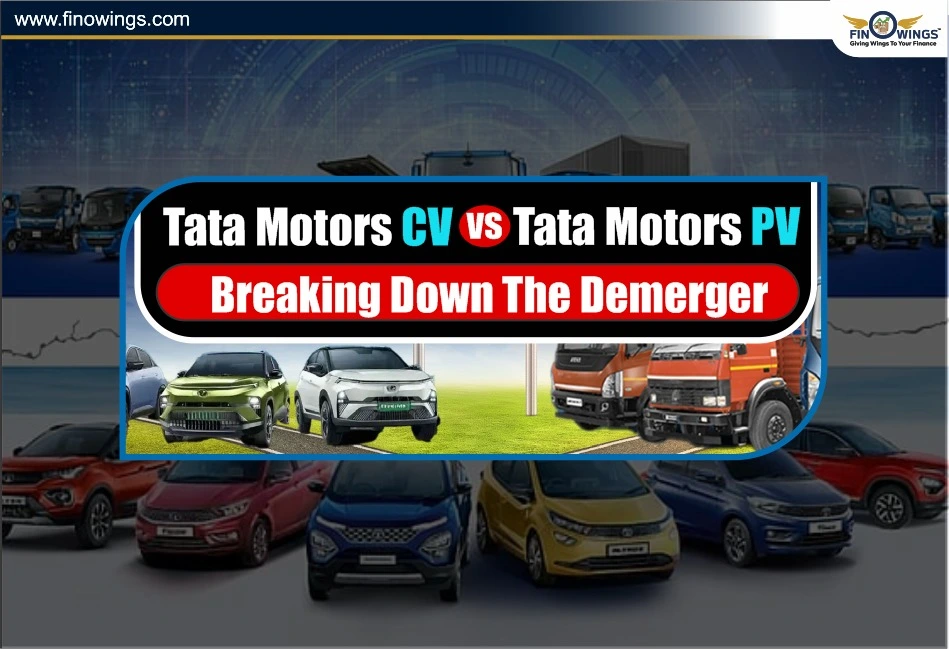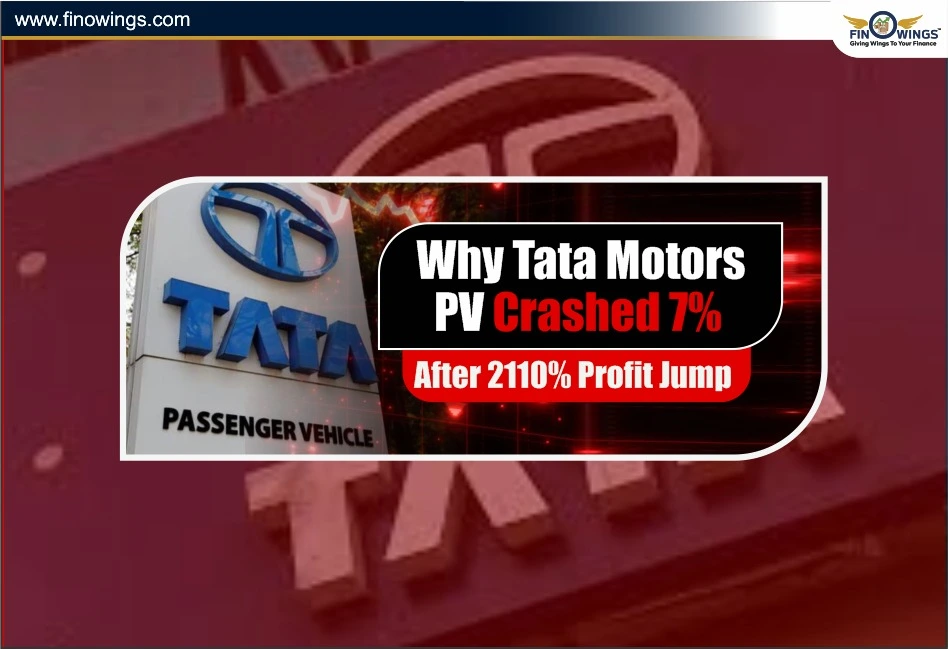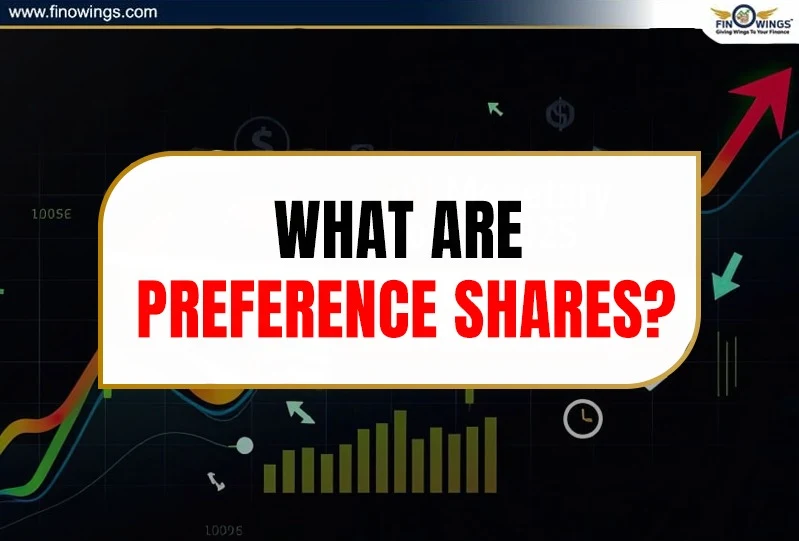Home >> Blog >> Tata Motors CV vs Tata Motors PV: Breaking Down the Demerger
Tata Motors CV vs Tata Motors PV: Breaking Down the Demerger

Table of Contents
- What Is the Tata Motors Demerger?
- What other reasons made Tata Motors Split?
- Tata Motors CV vs PV: Detailed Comparison
- What the Demerger Means for CV Business
- Tata Motors Passenger Vehicle (PV) Business - Passenger Vehicles + EV + JLR.
- What Investors Will Get from Tata Motors Demerger
- Response From The Market: Why Investors Are Optimistic
- Will Investors Have the Same Share in the New Company
- Which Is Better in The Long Term CV or PV
- Tata Motors PV Business: Ideal for
- Why the Tata Motors Demerger is a Game Changer
- Conclusion
The first event in Tata Motors' history was a demerger. Commercial Vehicles (CV) and Passenger Vehicles (PV) are the corporation's two separate business units. The company, its stockholders, the car industry, and any long-term intentions it may have are all anticipated to be significantly impacted by this much-anticipated demerger.
What does this demerger mean for the Tata Motors new entities? What are the new businesses expected to do? These are the main questions we will answer in this in-depth analysis with coverage on Tata Motors restructuring.
What Is the Tata Motors Demerger?
On June 29, the company received court approvals to undertake a scheme of arrangement splitting the company into two Tata Motors Ltd. & Tata Motors Passenger Vehicles Ltd. which will be listed separately. Under the two companies, we will have:
Tata Motors CV Business
-
Trucks.
-
Buses.
-
Small Commercial Vehicles.
-
Fleet Services.
-
EV Commercial Mobility.
Tata Motors PV Business
-
Cars/ SUVs (ICE).
-
Tata EVs (Nexon, Punch, Harrier, Curvv).
-
JLR (Jaguar Land Rover).
In this Tata Motors Demerger, the shareholders of Tata Motors Ltd. will be given the shares of Tata Motors Passenger Vehicles Ltd on a pro-rata basis and therefore they will own the same percentage in both companies. The rationale for this move is to create ‘sharper strategic focus’, and ‘independent capital structures’ which will unlock value for our investors.
What other reasons made Tata Motors Split?
Restructuring is a normal process, not a sudden development. It's the result of the growing business challenges & fast-paced transition in the industry.
The main reasons include:-
1. Different Business Cycles
The CV market is cyclical, driven by GDP growth, infrastructure spending, and logistics demand. The PV market is driven by consumer preferences, brand positioning, and EV adoption.
Having to manage each company individually was no doubt difficult as each company was under one umbrella.
2. JLR’s Size Distorting Tata Motors Valuation
The JLR segment generates most of the revenue and profit, and this overshadows the other domestic businesses of Tata Motors - the Passenger vehicles and the commercial vehicles divisions. The demerger will enable the investors to value each division of the business independently.
3. Sharper Leadership & Capital Allocation
The commercial and passenger vehicle divisions require different research and development and technology in addition to specific supply chains and market approaches. After the demerger:
The commercial vehicle division will receive funding to focus on hydrogen fuel, heavy electric trucks, and fleet services. The passenger vehicle division will receive funding to focus on the scaling of electric vehicles, new vehicle platforms, and partnerships with JLR.
4. Unlock Shareholder Value
Following a split of business verticals, established automotive companies such as Volvo, Daimler, and Ford have achieved remarkable market value. Tata Motors aspires to do the same.
5. India’s EV Push
Tata Motors Passenger Vehicles (especially Tata Passenger Electric Mobility (TPEM)) is thriving. A new separate identity will enable Tata Motors to attract more:
-
Global EV Investment
-
Tech Collaboration
-
Battery Production Partnerships
Tata Motors CV vs PV: Detailed Comparison
1. Tata Motors CV Business - Commercial Vehicles Division
Tata Motors Commercial Vehicles business line is the biggest in India and also the market leader in all the segments.
Key Highlights
-
Commercial Vehicles (CV) 40-45% market share.
-
Trucks, Light Commercial Vehicles and Buses Leader in the Global market.
-
Economic reasons: There is a high demand in logistics, mining, infrastructure and e-commerce.
-
Advertisements Electric Vehicle - Ace EV, Buses, e-fleet Solutions.
-
Development prototype Hydrogen Internal Combustion Engine (ICE).
-
Expanding Tata Fleet Edge and connected vehicle solutions.
What the Demerger Means for CV Business
-
Will have the ability to independently raise capital.
-
Quick resolution for B2B mobility.
-
Clearer balance sheets without Jaguar Land Rover (JLR) volatility.
-
Prioritise green commercial mobility (EV + hydrogen).
Be in a position to collaborate with major players in the global trucking and hydrogen.
This will increase between 2025 and 2030 as India will be enhanced in terms of infrastructure, operations, and freight.
Tata Motors Passenger Vehicle (PV) Business - Passenger Vehicles + EV + JLR.
The growth engine is the Tata Motors PV business.
Key Highlights
-
EV adoption in India is the fastest of any country.
-
Market leader in EVs with 70%+ share and in electric cars.
-
Strong SUV Portfolio: Nexon, Harrier, Safari, Punch.
-
New in EVs Gen 2 (Curvv), Gen 3 (Avinya), Platforms.
-
JLR’s global luxury range - Range Rover, Defender, Jaguar.
This now positions this business as a pure consumer brand with massive growth potential.
What Investors Will Get from Tata Motors Demerger
Implications of Demerger with Tata Motors separation:-
- The ability to raise funds with a focus on electric vehicles.
- JLR and Tata PV will further develop collaboration on synergic activities.
- Global associations will help focus on battery, software, and AI development.
- Having strategic consistencies will help eliminate the standalone CV cycle.
- Exclusive teams will help the company to innovate at an accelerated pace.
Investors will now be able to appreciate the value of Tata and JLR CV.
Response From The Market: Why Investors Are Optimistic
- More value from parts.
- Improved transparency.
- Improved parts profitability.
- Improved focus on strategic deployment of funds.
- Improved interest from institutional investors.
Analysts predict a positive increase in the value of the new/joint companies over a long time.
Will Investors Have the Same Share in the New Company
Yes. The split will be done in a mirror shareholding structure.
For example, if you have 100 shares of Tata Motors today, you will have 100 shares of Tata Motors CV and 100 shares of Tata Motors PV after the split.
There will be no dilution of shares. No loss of ownership.
Which Is Better in The Long Term CV or PV
That would be entirely subjective and would depend on the individual's appetite for risk.
Tata Motors CV Business: Ideal for:
-
GDP-linked growth.
-
Infrastructure and logistics boom.
-
Stability, along with recurring business-to-business demand.
-
Growth of new-age commercial electric vehicles.
Risk: Economic Slowdown & cyclicality
Tata Motors PV Business: Ideal for
-
Megatrend of electric vehicles.
-
Rebounding luxury with JLR.
-
High demand from consumers.
-
Global partnerships & focus on software mobility.
Risk: Increased research and development costs, competitive passenger vehicle market
Why the Tata Motors Demerger is a Game Changer
The Tata Motors Demerger aligns with the trends of global auto transformation. EVs will be their own business. Commercial vehicles will transition to green fuels. JLR luxury brands will be significantly autonomous. Focused auto companies are preferred by investors compared to conglomerates. The Tata Motors Demerger is viewed by analysts as a "value unlocking" strategy.
Conclusion
Tata Motors Demerger is a significant shift for both the Tata Motors CV business and the Tata Motors PV business. Tata Motors Split allows for a much clearer, cleaner and strategic shift with more agility.
As the auto industry moves to EVs, digital transformation, autonomous systems and commercial mobility on hydrogen, both new companies will continue to be at the forefront of powerful, groundbreaking trends.
If monitoring the Tata Motors Commercial Vehicle vs Passenger Vehicle Segment debate, or analysing potential future investments, there is one certainty: the Tata Motors Demerger is the starting point of a new journey to create and capture value.
DISCLAIMER: This blog is NOT any buy or sell recommendation. No investment or trading advice is given. The content is purely for educational and information purposes only. Always consult your eligible financial advisor for investment-related decisions.

















